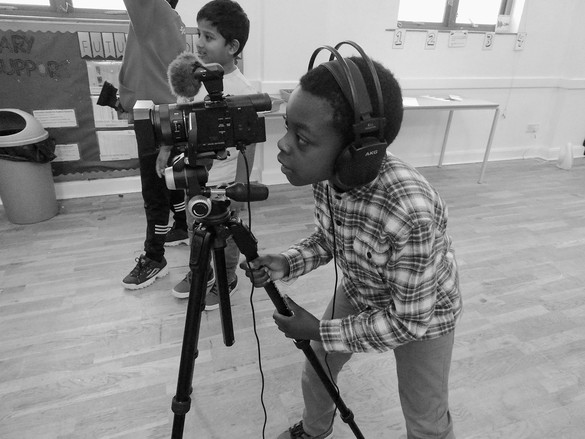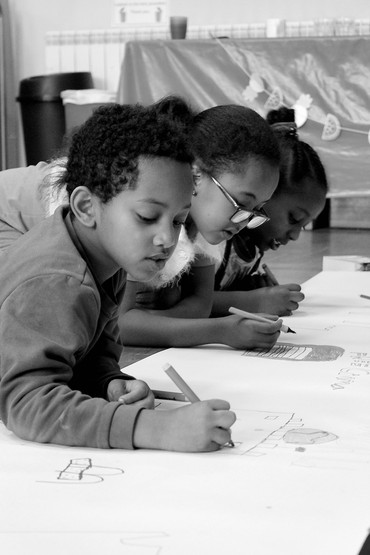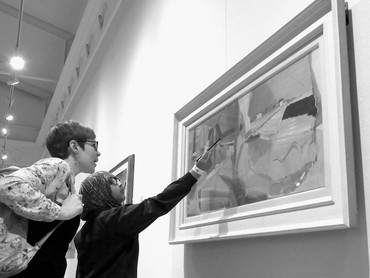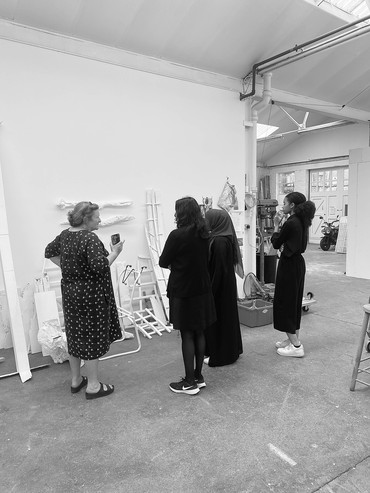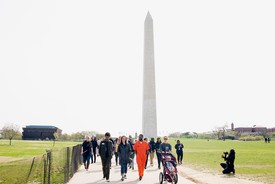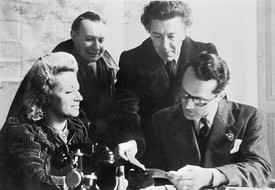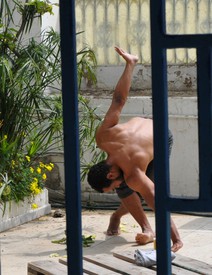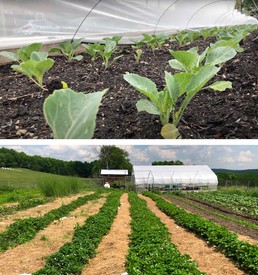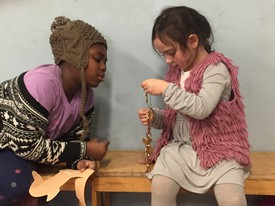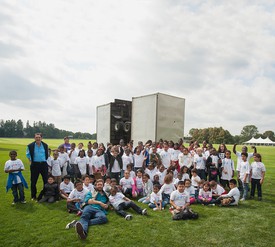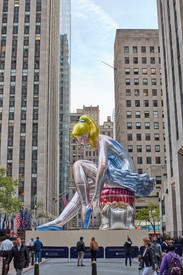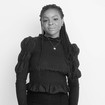
Precious Adesina is a London-based freelance journalist who specializes in arts and culture and often explores sociopolitical topics. She writes for a number of publications, including the New York Times, the Financial Times, the Economist, and BBC Culture, and has given many talks and panel discussions at British galleries on arts writing and research.
In May 2017, the London-born artist Khadija Saye displayed her work at the Diaspora Pavilion, an exhibition at the 57th Venice Biennale. The show included pieces by nineteen artists at both the beginning and more-established stages of their careers, so that Saye’s creations appeared alongside those of industry stars such as Isaac Julien, Hew Locke, and Yinka Shonibare; it was set to be a career-changing moment for the twenty-four-year-old. Saye’s friend Sanaz Movahedi remembers her speaking about “how excited she was that one of her idols, artist Lorna Simpson, had come to admire her work” in Venice. “She was so gracious about being there, and so excited about the opportunities it would open up for her career in the art world,” Movahedi wrote in the Guardian. But Saye lived on the twentieth floor of Grenfell Tower, a twenty-four-story block of flats in North Kensington, west London, where a fire that June tragically claimed the lives of over seventy residents, including Saye, in one of the worst disasters in modern British history.
Two years after Saye’s death, painter Nicola Green founded Khadija Saye Arts alongside the nonprofit organization IntoUniversity. Created in memory of the Gambian-British photographer, the program gives young people from modest backgrounds like Saye’s the chance to explore various aspects of the arts. For roughly a decade, beginning when she was seven, Saye was an active member of IntoUniversity, which supports young people facing disadvantage to achieve their goals by helping them to access higher education and other opportunities that fit their aspirations. Since its founding, in 2002, IntoUniversity has opened almost forty centers across Britain and has helped hundreds of thousands of young people at risk of not achieving their full potential. “We first started IntoUniversity as a small local program running out of a community center in North Kensington to help young people from the area,” says Dr. Rachel Carr, the organization’s cofounder and chief executive. The charity delivers academic support sessions, one-to-one mentoring, workshops, and career development opportunities. “Now we’re celebrating our twentieth anniversary, and many of the young people we first worked with are adults with successful careers.”
IntoUniversity tries to directly counteract the disparity in the prospects of students from different backgrounds in the UK. “We know that young people facing disadvantage are over four times less likely to attend higher education than their most advantaged peers,” says Carr, noting that the information IntoUniversity has gathered over its two-decade-long existence has proven how vital the organization’s support has been. According to a recent impact report by the charity, two thirds of IntoUniversity’s school leavers in 2021 went on to higher education; across Britain, that number for other young people from similar backgrounds was less than a third. “It’s about helping young people figure out what type of career or role they’d like to do and getting them exposure to relevant opportunities,” adds John Bleasdale, IntoUniversity’s assistant director of development.
According to Green, Saye credited IntoUniversity with helping her to jump-start her future. “The barriers to even thinking about the arts as a career, let alone [getting a qualification in art], prevent so many talented children from getting past the first post,” says Green, who mentored Saye. “Khadija told me how IntoUniversity had supported her at after-school homework clubs, introduced her to Carnival Arts, which began her creative journey, helped her buy a camera, and facilitated her scholarship to [the private school] Rugby.” The Carnival Arts program, which Saye joined in 2013, lets children create their own costumes for Notting Hill Carnival, a monumental annual event celebrating British-Caribbean culture that has taken place in London since 1966. “She told me [IntoUniversity] taught her how to seek help, advice and opportunities, which is how we met.”
Green first met Saye in 2014, not long after the young artist had graduated with an undergraduate degree in photography from the University for the Creative Arts, a specialist art-and-design university in Farnham, England. Green selected her work for the Discerning Eye competition, an annual exhibition at Mall Galleries in central London. “I met her at the opening night, with her proud mother Mary,” says Green, noting that it was Saye’s first show and she had taken out a loan to frame her work. “She explained how she was working, like her mum, in a care home and had no prospect of paying off the bank loan for the frames.”
The current financial situation in the UK has only made social mobility harder for many young people. “The recent economic downturn as a result of the pandemic and the cost-of-living crisis is adding further strain to families and communities that are already struggling,” says Carr. “We’re working with young people from the least privileged backgrounds who don’t necessarily have access to tutoring or have much space or resources at home,” adds Bleasdale. He says that many students at IntoUniversity returned from the pandemic showing very little progress in crucial subjects. “Literacy and numeracy had not improved, so you had young people in year seven, returning in year nine, after two years of interrupted learning, which created serious learning gaps.” John believes the pandemic further stressed the need for organizations such as IntoUniversity. “Our programs are set up to help young people overcome that.”
Among the things that make the program so valuable is that it allows students to see the arts as a viable professional career.
Khadija Saye Arts uses the techniques that IntoUniversity has learned over the past twenty years to create more possibilities for young people eager to get into creative industries. “One of the main things that we wanted to address with the arts program is the lack of diversity within the UK arts sector,” says Jade Morgan, IntoUniversity’s arts program manager, who oversees Khadija Saye Arts. According to a study by researchers at the universities of Edinburgh, Manchester, and Sheffield, creatives with parents who have working-class jobs accounted for about 37 percent of the industry workforce in 1981; by 2011, that number had fallen to 21 percent. Additionally, according to the Guardian, an analysis of Office for National Statistics data found that 16.4 percent of creative workers born between 1953 and 1962 had a working-class background, but for those born four decades later, that number had fallen to just 7.9 percent. “It’s poor,” adds Morgan. “It’s not a representation of what the UK stands for.” The British researchers saw creative occupations as “jobs that are considered to be most involved in creating, curating and presenting the culture that we consume,” such as artists, musicians and actors, and people working in the media or museums and galleries.
Khadija Saye Arts tailors its approach to the age of its pupils. With students under the age of sixteen, it incorporates the arts into activities they are already doing with IntoUniversity. In contrast, older students and alums above sixteen who have shown keenness for the creative industries are provided with more practical skills. “I sit in a team called the Student Opportunities Team,” says Morgan. “That’s where we can offer internships, insight days, or even sessions on building portfolios.” Morgan explains that older students at IntoUniversity often have a clearer idea of where they want their life to head, which allows her to be more specific. “We can make it a lot more nuanced and focused.”
Among the things that make the program so valuable is that it allows students to see the arts as a viable professional career. “There’s a misconception about the arts being a hobby,” says Morgan, noting that bright working-class students are often pushed toward stem subjects and careers, a pressure that leads them to see that path as the only way to build a life for themselves. “They have ambition and want to get out of their situation,” says Morgan. “They don’t see the arts as something sustainable that will support their family, so I’m here to oversee the program and ensure that we are doing what we need to do.”
A key way of creating practical support is through partnerships with a variety of organizations that deal with the arts, ranging from Gagosian to the financial institutions BlackRock and UBS. “Before the young people even set foot in these places, there’s a certain level of apprehension,” Morgan says, describing how students often believe they don’t belong in art spaces. “We are there to say ‘No, you do belong here.’ We’re trying to break down those barriers.”
With Gagosian, three students embarked on a three-week internship in July 2022 that included an application and interview process, a week at King’s College London preparing them for the working world, which included developing student’s soft skills alongside leadership coach Seth Wainwright, and two weeks learning about different areas of the organization. “This hands-on experience shapes them,” Morgan says. “Their minds shifted so much on what they wanted to do [as careers]. It was such an invaluable experience.” Laiba Asif, who had just completed her A-Level exams at the start of the internship, says it introduced the students to roles in the industry they were unaware of, “which was valuable for me as someone trying to envision a career in the art field.” Kaya Forde, who hopes to study illustration at university, agrees: “I have always seen and been involved with the practical side of the art world and did not realize how big the technical, behind-the-scenes side of the art world was. It was really insightful, and I am grateful to have this information going forward in my art journey.”
Increasing diversity within the creative industry isn’t helpful only to people from working-class communities; it benefits organizations too. “Diverse groups engage in ‘creative conflict,’ which leads to better decision-making, introduces new ideas into discussions and increases creativity and innovation,” writes Jill Gould, a researcher at the University of South Australia, on the news website The Conversation, written by academics. “Diverse groups generate hard-to-imitate resources leading to competitive advantage.”
At only twenty-four, Saye was already starting to make her mark on the art world. As the medium for her work she chose the wet-collodion process, invented in 1851, producing photographs with an ethereal quality. “Within this process, you surrender yourself to the unknown,” she said. While Saye may no longer be making art, through IntoUniversity and people who care about her she is providing opportunities for others, in similar positions to hers, to succeed as she did.
Photos: courtesy IntoUniversity
